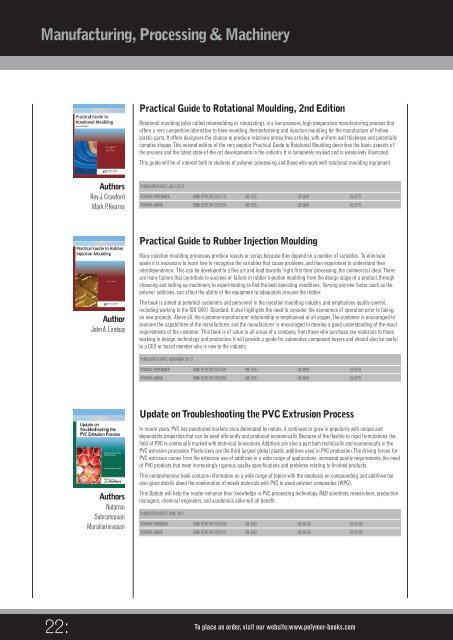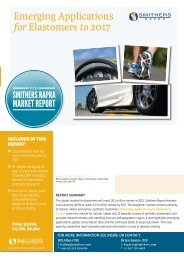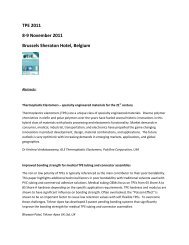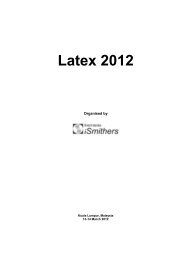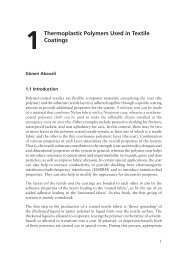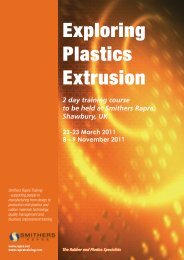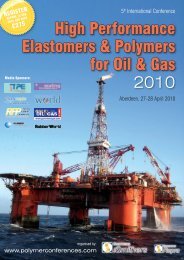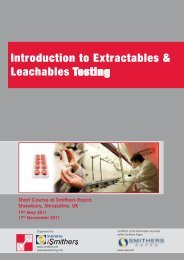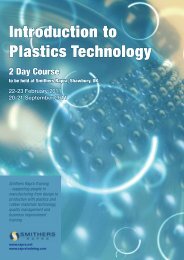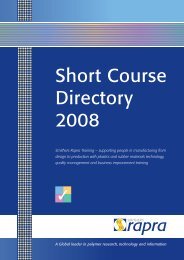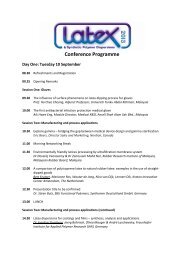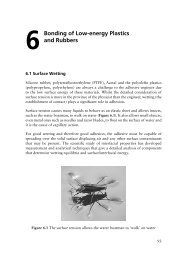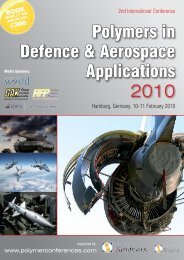download our 2013 catalogue - Smithers Rapra
download our 2013 catalogue - Smithers Rapra
download our 2013 catalogue - Smithers Rapra
Create successful ePaper yourself
Turn your PDF publications into a flip-book with our unique Google optimized e-Paper software.
Manufacturing, Processing & Machinery<br />
Practical Guide to Rotational Moulding, 2nd Edition<br />
Rotational moulding (also called rotomoulding or rotocasting), is a low pressure, high temperature manufacturing process that<br />
offers a very competitive alternative to blow moulding, thermoforming and injection moulding for the manufacture of hollow<br />
plastic parts. It offers designers the chance to produce relatively stress-free articles, with uniform wall thickness and potentially<br />
complex shapes. This second edition of the very popular Practical Guide to Rotational Moulding describes the basic aspects of<br />
the process and the latest state-of-the-art developments in the industry. It is completely revised and is extensively illustrated.<br />
This guide will be of interest both to students of polymer processing and those who work with rotational moulding equipment.<br />
Authors<br />
Roy J. Crawford<br />
Mark P. Kearns<br />
PUBLICATION DATE: July 2012<br />
FORMAT: Paperback ISBN: 9781847355119 GB: £55 US: $90 EU: €70<br />
FORMAT: eBOOK ISBN: 9781847355126 GB: £55 US: $90 EU: €70<br />
Practical Guide to Rubber Injection Moulding<br />
Author<br />
John A. Lindsay<br />
Many injection moulding processes produce rejects or scrap, because they depend on a number of variables. To eliminate<br />
waste it is necessary to learn how to recognise the variables that cause problems, and then experiment to understand their<br />
interdependence. This can be developed to a fine art and lead towards ‘right first time’ processing, the commercial ideal. There<br />
are many factors that contribute to success or failure in rubber injection moulding from the design stage of a product, through<br />
choosing and setting up machinery, to experimenting to find the best operating conditions. Varying any one factor, such as the<br />
polymer additives, can affect the ability of the equipment to adequately process the rubber.<br />
The book is aimed at potential customers and personnel in the injection moulding industry, and emphasises quality control,<br />
including working to the ISO 9001 Standard. It also highlights the need to consider the economics of operation prior to taking<br />
on new projects. Above all, the customer-manufacturer relationship is emphasised at all stages. The customer is enc<strong>our</strong>aged to<br />
examine the capabilities of the manufacturer, and the manufacturer is enc<strong>our</strong>aged to develop a good understanding of the exact<br />
requirements of the customer. This book is of value to all areas of a company, from those who purchase raw materials to those<br />
working in design, technology and production. It will provide a guide for automotive component buyers and should also be useful<br />
to a CEO or board member who is new to the industry.<br />
PUBLICATION DATE: November 2012<br />
FORMAT: Paperback ISBN: 9781847357076 GB: £55 US: $90 EU: €70<br />
FORMAT: eBOOK ISBN: 9781847357083 GB: £55 US: $90 EU: €70<br />
Update on Troubleshooting the PVC Extrusion Process<br />
Authors<br />
Natamai<br />
Subramanian<br />
Muralisrinivasan<br />
In recent years, PVC has penetrated markets once dominated by metals, it continues to grow in popularity with unique and<br />
dependable properties that can be used efficiently and produced economically. Because of the flexible to rigid formulations, the<br />
field of PVC is continually marked with technical innovations. Additives are also a part both technically and economically in the<br />
PVC extrusion processes. Plasticizers are the third largest global plastic additives used in PVC production. The driving forces for<br />
PVC extrusion comes from the extensive use of additives in a wide range of applications, increased quality requirements, the need<br />
of PVC products that meet increasingly rigorous quality specifications and problems relating to finished products.<br />
This comprehensive book contains information on a wide range of topics with the emphasis on compounding and additives but<br />
also gives details about the combination of woody materials with PVC to wood polymer composites (WPC).<br />
This Update will help the reader enhance their knowledge in PVC processing technology. R&D scientists, researchers, production<br />
managers, chemical engineers, and academics alike will all benefit.<br />
PUBLICATION DATE: June 2011<br />
FORMAT: Hardback ISBN: 9781847355508 GB: £80 US: $130 EU: €100<br />
FORMAT: eBOOK ISBN: 9781847355515 GB: £80 US: $130 EU: €100<br />
22:<br />
To place an order, visit <strong>our</strong> website:www.polymer-books.com


